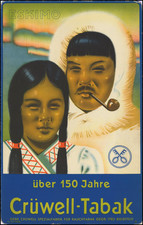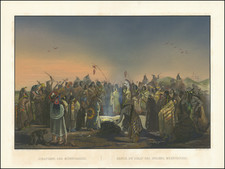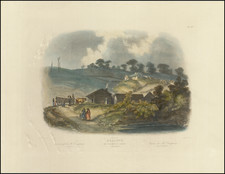Karl Bodmer's exquisite hand-colored aquatint portrays Péhriska-Rúhpa, a Minitari Indian, also known as Two Ravens, in a compelling blend of artistic mastery and ethnographic detail. This print stands as a vivid documentation of the indigenous people encountered by Bodmer during his journey across the American frontier in the early 19th century.
The original drawing for this aquatint was completed in March 1834 at Fort Clark. Bodmer was drawn to the elegance of Péhriska-Rúhpa's attire, which merited not one but two separate portraits. The present work features the Minitari leader in his everyday clothing, each piece meticulously detailed. His shirt, leggings, and robe are impressively ornamented, embodying the rich cultural tapestry of the Minitari people and their intricate craftsmanship.
The second portrait, referenced as Tableau 23, shows Péhriska-Rúhpa in the ceremonial regalia of the Hidatsa Dog Society, underscoring his status as a principal leader. Together, these portraits serve as a window into the diversity of the Minitari's material culture, while providing a testament to Bodmer's attention to ethnographic accuracy.
This aquatint stands as more than just a piece of art—it encapsulates the intersection of cultures and the interplay of observation and artistic representation that was inherent in Bodmer's work. The portrait of Péhriska-Rúhpa remains a vibrant testament to the richness and diversity of indigenous cultures in 19th-century North America.
State
Ruud's 4th of 7(!) states, with the printer's credit but without the English title.









![[ Pictish Warrior Woman ] Feminae Pictae icon V](https://storage.googleapis.com/raremaps/img/small/99648.jpg)
![[Original photograph] Native Americans, possibly Creeks, in outdoor camp with white settlers or Indian Agents.](https://storage.googleapis.com/raremaps/img/small/78740.jpg)


![(North Dakota) Scalp Dance of the Minatarres [near Fort Clark, on the Missouri River]](https://storage.googleapis.com/raremaps/img/small/77692.jpg)
